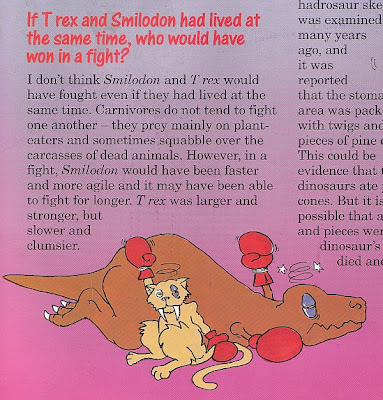Experiencing feelings of déjà vu? It's quite all right - you're getting on a bit now, and your delicate mind isn't quite what it was. But apart from that, David's looked at this book before - all the way back in
December 2009. Unfortunately, owning a fragile hardback edition prevented him from scanning anywhere near as many pages as he wanted to. Good thing, then, that I have come into possession of a similarly historical paperback edition from 1974. Check out Mr Orr's original post if you haven't already, and then join me for more from this intriguing book!
Peggy Parish and Arnold Lobel were (and maybe still are, posthumously) apparently big names in the world of children's books in the USA - David described them as "giants" in his post. However, I hadn't heard of them before acquiring this book. I should probably feel ashamed, but on the other hand I have a feeling that Parish and Lobel might not have made so much of a splash over here - I can reassure you that I
did read a lot of books as a child. In any case, this is a book clearly aimed at very young children who are just starting to read, and both that simple text and Lobel's stylised saurian renditions are very charming.
While stylised and a little fanciful, Lobel's dinosaurs still resemble the animals in question and often appear to draw from more 'serious' well-known palaeoart of the time. Zallinger and Burian appear to be major sources of inspiration. The
Stegosaurus,
Diplodocus and
Ankylosaurus (with its light brown colour) in particular are reminiscent of illustrations by Zallinger appearing in
Dinosaurs and Other Prehistoric Animals.
Where the inspiration for this bronto (below) came from, however, is harder to ascertain - presuming Lobel didn't just draw it from his imagination. Although enormously rotund, it at least doesn't suffer the indignity imposed upon
Brachiosaurus...
...which is described, rather bluntly, as "fat". Not just fat, in fact, but "too fat to run from enemies," and hence in need of the protection of water. 'Cos everyone knows that theropod dinosaurs melt upon exposure to the slightest drop of water, a bit like the Wicked Witch of the West from
The Wizard of Oz or the rubbish aliens from
Signs. Have you ever seen a bird in a thunderstorm? No? EXACTLY.
Of course, I don't blame Parish/Lobel at all for this silliness; it was standard fare at the time. Indeed, similar ideas are espoused in
DaOPR, while the illustration appears to borrow from Burian.

As was traditional back then, long before the discovery of the more visually arresting
Microraptor,
Compsognathus is the representative for 'small dinosaurs' in general. I love the unusual composition of this illustration - the rocks simultaneously make the dinosaur seem tiny (by filling most of the space) and help draw attention to it by placing it on a 'podium'. Unusually,
Compsognathus is illustrated here with four fingers. It had three in reality, but for many years was widely thought to have two (as in
The Ultimate Dinosaur Book), based on an incomplete specimen.
Another interesting entry in this book, and one that seems unusual for a short kids' book, is
Teratosaurus. Here the animal is presented as a theropod, as was assumed until the mid 1980s, when it was found to be a non-dinosaurian archosaur, namely a rauisuchian. The skulking theropod depicted by Lobel is reminiscent of many, many depictions of
Megalosaurus, including
Neave Parker's. From reading around I get the impression that
Teratosaurus as painted by Peter Zallinger also looked somewhat like this, but I haven't seen that one (and so cannot verify).
Here we have the animal currently mostly known as
Edmontosaurus annectens. This is a fairly standard hadrosaur for the time with Lobel's usual stylistic touches giving it a rather anthropomorphic air (although not as much as his loungin'
Ornithomimus) and a very odd neck.
This is probably my favourite illustration in the whole book - and not just because it's that much bigger than the others (although that certainly helps). I think it's mostly down to exactly how pleased with itself this rather toad-like
Pentaceratops looks - it's probably because he has the longest nose horn in the whole herd. The head definitely owes more to
Triceratops than
Pentaceratops (although the frill is too rounded for either). Incidentally, the look of this lumpen, crosshatched creature reminds me very much, for whatever reason, of illustrations from books by British children's illustrator/author team Janet and Allan Ahlberg (now
there are names I remember from my childhood).

And finally...that big theropod. You know the one - coelurosaur, atrophied forelimbs but powerful, muscular hindlimbs, quite possibly the only animal alive
or dead to be routinely referred to by its
abbreviated scientific name among the general public. That's right... C-Casuarius!
 |
| Photo by Bjørn Christian Tørrissen, from Wikipedia. |
Only joking - it's that obscure Late Cretaceous species
Tyrannosaurus rex. Lobel's given it a particularly fearsome, bloodthirsty air, with the blank eyes, slit pupils and dragged tail of a cold-blooded killer. Worthy of note is that this is the only dinosaur in the book to be depicted against a background of volcanic activity, no doubt intended to further add to the sense of fear and foreboding.
Dinosaur Time is a charming little book the likes of which we are, unfortunately, seeing fewer and fewer of now. Most kids' dinosaur books these days content themselves with illustrations that are straight knock-offs of those by more accomplished artists, or terrible CG 'reconstructions' hardly worthy of that designation. If only there was an artist out there who was somehow able to mix anatomical accuracy with whimsical charm, quirkiness and a finely detailed, 'fairytale' art style, and if only a publisher would commission said
entirely hypothetical person for a dinosaur book...we can but dream...




































